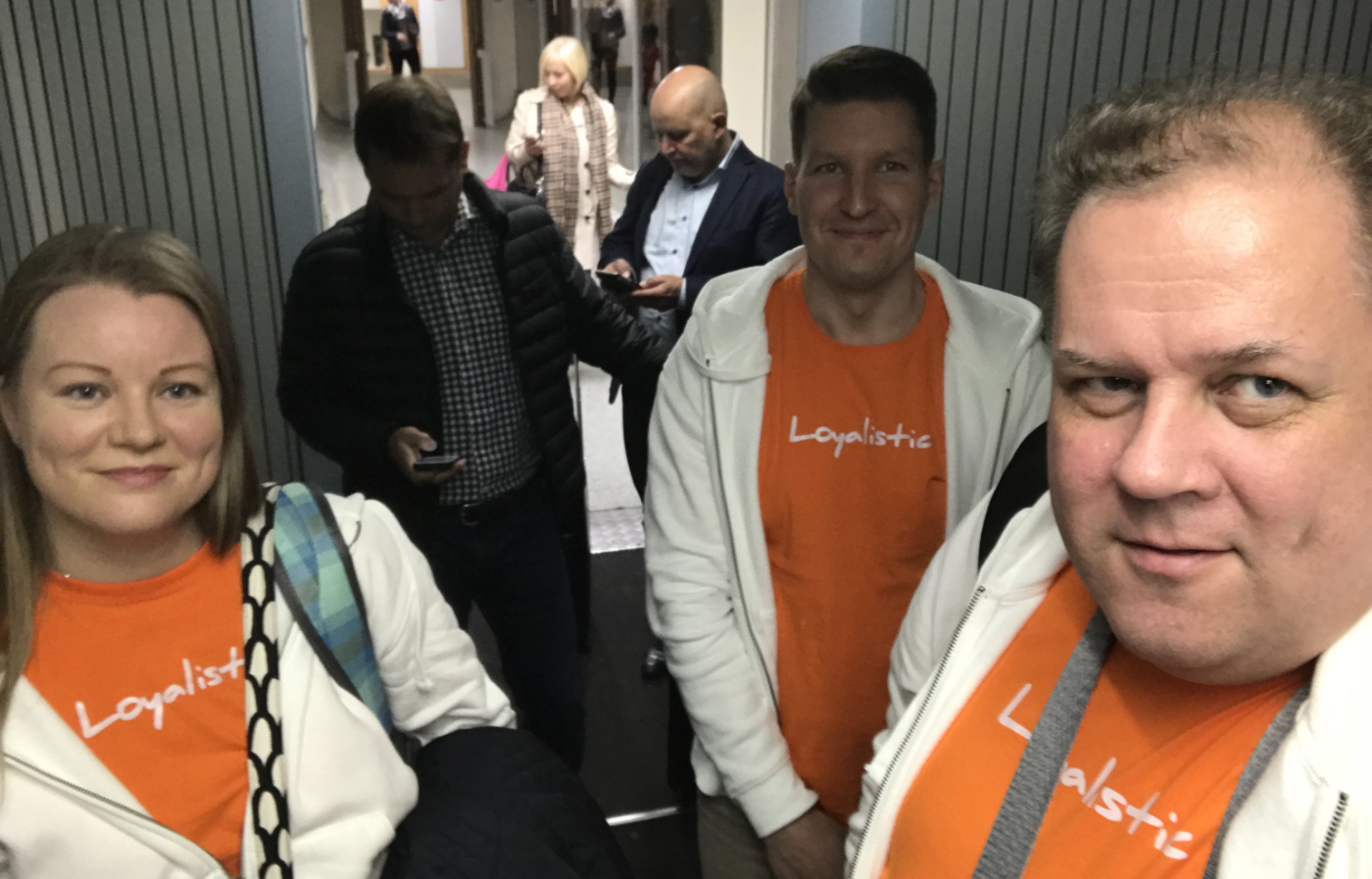We just got back a couple of weeks ago from SaaStock 2018 in Dublin, Ireland where we had a chance to listen dozens of keynotes from world's leading Software-as-a-Service leaders, thinkers, doers and financiers, and share thoughts with fellow entrepreneurs, marketers and CTOs.

Should you be interested, if SaaS is not your line of business? Very much so. If you want to see the future of B2B sales, marketing and growth, there it is.
If SaaS is your line of business, you can skip straight into what were the key take-aways, was it worth it, and are we going back in 2019?
SaaS business is years ahead of other businesses in sales, marketing and growth
For the last 20 years, I have been working with leading companies in both B2C and B2B in sales and marketing: consulting, designing tech solutions etc. I have read over 500 business books, wrote over 200 blog posts about customer loyalty and worked with the best consultants, tech and agencies in that space.
Then a few years ago when we started building our own product, I wanted to learn everything I could about how to succeed in SaaS business.
SaaS means Software-as-a-Service where you pay, usually a monthly fee, for using a cloud based software. No licenses, no servers, no installation...
Now majority of business software is sold that way.
SaaS was followed by a number of other "aaS" terms, first in IT, like Infrastructure-as-a-Service and Platform-as-a-Service, but "aaS" movement is now expanding rapidly everywhere including e.g. Mobility-as-a-Service.
This as-a-Service movement is now called Subscription Economy as the same success models are applied to various businesses from razor blades (Dollar Shave Club) to music and tv (Spotify, Netflix) and to even ecommerce deliveries (Amazon Prime).
I soon noticed that this SaaS industry was years, and even decades, ahead of traditional leading industries when it comes to sales, marketing, customer loyalty and really anything related to growth. Why?
SaaS product is a digital product, it can often be purchased online, and is used online.
It can be delivered anywhere in the world with virtually no delivery costs. Variable costs are very low with margins close to 100 %. There are very few reasons why a digital product should be sold face-to-face, thus most are sold online or with the help of inside sales. Such a business is highly scalable. The flip side? There is very little protection from global competition. Thus economics favor growth, global growth.
Best teams can get from zero to tens of thousands paying corporate clients with millions of users in less than 5 years. And all those customers are direct, no channel in between, so all future revenue is almost 100 % profit once customer acquisition costs are covered. It's easy to see why listed SaaS companies are valued at around 10 times their annual recurring revenue (ARR) and many are worth billions of dollars.
Phenomenal growth opportunities attract the best entrepreneurs, sales leaders and doers, growth and marketing experts, and venture capital, all with big ambitions.
And those ambitions require tools and practices that help win races, not second places.
Most start with no or limited funding, yet with each milestone reached, can upgrade to next level with more funding: 100k, 1 million, 10 million, 100 million... If you had a team of 36 in the beginning of the year, by October you may already have 144. If you started with one marketer, you may end up having 40 marketing teams five years later.
Very few nail their business model from the beginning and have to go through a number of pivots. Yet it's surprising how similar the model stays once nailed whether it's early days with a few guys with laptops or later days with the said 40 marketing teams (on one product). Same principals, methods and tactics may be used along the way, yet fast growth rates may result in changing tools like CRMs more often than many buy a new pair of jeans. SaaS is very digital and thus highly data driven with automation in the level other businesses cannot often even dream about.
So if growth, sales or marketing interests you, then SaaS is the industry you should definitely follow. This is the frontier where new things are tested and invented - welcome to the territory beyond best practices!
What's the best growth model for your business?
Sales or marketing. Inbound or outbound. Self-service or ...?
Some believe in sales, some in marketing, others in product...
David Skok, our team's "best keynote" winner, structures the question this way. Each model has typically a different customer acquisition cost. That cost has to make sense to your annual contract value and lifetime value.
Your customer acquisition cost typically depends on the growth model, more precisely, on sales complexity.
| Rough Estimates of Cost of Customer Acquisition (CAC) | |
| Freemium/viral | $0-10 |
| No Touch Self-Service | $50-200 |
| Light Touch Inside Sales | $1,000-2,000 |
| High Touch Inside Sales | $3,000-8,000 |
| Field Sales | $25,000-75,000 |
| Field Sales with Sales Executives | $75,000-200,000 |
Many, at least here in Finland, might argue these figures are way too high, but it's good to remember that Skok (and other VCs) have lots of experience in these matters. You may be able to acquire customers a lot cheaper locally or initially, but as the business scales and you have to expand to new territories and niches, CAC tends to go way up.
It's quite common here in Finland, that SaaS companies use field sales for products with Annual Contract Value (ACV) of a few thousand euros (or dollars). It might make sense while selling within Helsinki's Ring 1 where most decision makers are located as it takes 15-45 minutes to drive from a meeting to a meeting, yet the math is quite different when you set up the first country office.
Selling can be the worst way to sell
Content marketing has worked extremely well for the SaaS companies during the recent years as noted by a number of speakers, and it is obviously starting to change how we sell. Most use it for generating inbound leads.
But many B2B SaaS products are designed for specific kind of organizations that can be identified and contacted. In such cases pure inbound strategy might not be the best option. But what if we tweek it a bit?
David Skok argues that the predominant sales model of booking meetings with cold calls is probably the worst way to sell as very few people like to be sold to if they are not ready.
And according to another source, only about 3 % of those who are interested, are actually ready to buy.
So most of the time, you are selling to people who do not like to be sold to.
As I said earlier, SaaS industry is among the first to try new things and finding edge, but the one thing I am not proud of are all the cold outreach technologies used by SaaS companies to reach more people faster, or again to be more precise, harass more people quicker.
Robocallers and cold email outreach automation are so harmful for the industry in the long run. I receive quite a number of robotised calls and automated cold outreach sales campaigns each week. The end result: I don't answer phone calls from unknown numbers and I don't open emails from unknown senders.
In the pursuit of more discussions with harder and harder to reach decision makers, sales organizations are using automation to disturb more and more of the target market with less and less relevant offering.
David Skok is suggesting exactly the same as I have been suggesting for our clients. Use that first contact to invite person to e.g. a high value webinar (not a sales webinar, but a content webinar), build a relationship with valuable content and sell to only those who have shown real interest.
The big question: what's the next big thing in growing a B2B company?
Over the course of the event, I noticed many speakers were kind of expecting that the audience expects them to tell the next big thing, the must-have method of year 2018 or 2019, and were trying to answer that.
Lots of effort was made to explain why their thought is the next thing, yet most fell short of actually providing any good evidence.
One argued that blogs, ebooks, podcasts and videos are so last season as everybody is doing them. And the future is - drum droll please - branding. Another argued that it's positioning. Then another that it is the product. Then price. Then...
Sorry guys, but it's not that simple. You are telling the obvious, like if we would have forgotten all the basics of marketing e.g. 4Ps.
Some argued cold emails are the thing. Some that it's chat. Some put their faith in content. And so it continued.
Yes, every keynote was well worth listening, but mostly makes your head spin more, not less.
What was missing, at least from those I participated, is the framework what makes them all make sense. And they actually do.
Marketing is not just one thing, it's a complex thing with many details that have to be perfectly aligned, like place, price, product, promotion... the 4Ps. A customer's journey, which for a B2B product can be long, has to be paved with content, marketing and more. One tool, whether cold email or chat, solves just one part of the puzzle. Yet all the parts are needed to get the system working and pumping new business.
I will probably have to come back to this with a matrix later on.
So let's assume there is a right place for each tactic at such a matrix, but is there the next big thing?
For the last years content marketing has been a really big growth driver for many SaaS companies. It has worked really well, as many admitted. Too well, it seemed. But as blogs were extended to ebooks, then video and finally to podcasts, all obvious places are covered and it's natural to search for any tactic with less competition.
Yet my analysis is that we are probably not going to see it. The content revolution is filling the vacuum of the information need that was left unfulfilled by the traditional media, and opened up by the internet, social media, self-publishing like blogs, vlogs and podcast, search engines... This vacuum is fastly filling up, while new vacuums are not obvious.
Nothing really new and fundamental has been invented in recent years e.g. no new social media that would transform the way customers spend their time and where we as marketers could reach them. Free ways are getting quickly monetized. Google and Facebook cover most of the ground, with Microsoft playing catch up with LinkedIn...
There is one thing that can change things, but not neccessarily for easier, and they are the voice first services like Amazon Alexa Flash Briefings.
Yet my outtake is that easy opportunities are quickly melting away and marketing is going to be harder and harder. Sorry. But, reaching potential buyers with cold calls is going to be even harder. No pain, no gain.
Product-led growth
Yet if the next big thing is something you are after, it's probably going to be product-led growth (PLG) like Adam Marcus from OpenView Venture Partners presented.
What does it mean?
It just means that the product is so good, that people will buy it. Common sense, you say?
Not in B2B.
Most enterprise softwares are sold to people who do not use the softwares themselves. So they buy the promises made in sales presentations or marketing. They buy the benefits and believe the features will actually materialise the benefits.
Product-led growth means you are actually demonstrating, with the product, that the customer will succeed, and often this demostration is done by the customers themselves by trying the product for free.
Also the way software is bought has changed and is changing. So-called gray IT means that someone brings in a software to use within their team, and then the word starts to spread. And finally IT has to make it official. Sometimes this happens, sometimes a SaaS company has to make it happen. The latter is called land and expand strategy.
Many SaaS companies are really focused on customer success, meaning that they focus on getting a customer to get the benefits, not just promising them, as it is the standard in traditional software industry and most other B2B industries. But although many care about customer success, many are still too focused on growing by selling faster, the traditional way.
Product-led companies are fortunately performing way better. They are 2x more valuable, said Adam Marcus. He actually provided quite much evidence that you are far better off by growing with a product it front rather than sales or marketing. Great presentation overall.
John Sherer from AppCues reminded us that in the PLG world, your pipeline, funnel or whatever you call it, must be based on prospect behaviour, not rep behaviour. Again common sense, but so often forgotten.
How to differentiate when you have 7 000 competitors
Drift, a chatbot company if you like, is one of the marketing technology vendors, just like our company Loyalistic. Couple of years ago, there were a few hundred idenfied vendors in that space in less than 10 categories, today over 7 000 vendors!
Drift's VP of Marketing, David Gerhardt shared his views on how to get around this problem. He didn't really have any real answers other than be authentic and so forth, and that SaaS industry is still taking its first steps in branding, however, the example given earlier in the presentation, and found above, was superb.
RxBar is an energy bar, just like any of the dozens of brands you'll find at your local store. In all, there must be thousands of brands in that space. And RxBar wasn't doing great with the packaging on the left in the photo below.
When asked how they would pitch it, they answered that it's like eating three egg whites, two dates and six almonds. This became their new way to communicate as seen on the right. Exponental growth followed and soon after the company was sold at 300x valuation.
Work-life balance? Forget it.
Do you believe in work-life balance, remote work, having hobbies? You shouldn't, said Patrick Cambell.
Patrick Cambell from ProfitWell (formerly Price Intelligently) shared lots of interesting stories, and plenty of data. The two-time cancer survivor Cambell told his story and the mistakes made, and finally the recent survey results. Interestingly, startups in which founders believe in work-life balance do not succeed as well as in which they don't (and just work their asses off). Similarly, remote startups do not succeed as well as unremote ones. And finally, founders who believe you should have a hobby, underperform those who believe work is the only hobby a founder needs.
Unfortunately I don't have any pictures worth sharing from Cambell's fantastic keynote.
Was SaaStock worth 3 000 euros it cost us to attend?
During the two days in SaaStock, over 100 presentations or panel discussions were held. The video archive ends at #101. I didn't count how many I participated, but it must have been many based on the number of photos and notes taken.
So was it worth the investment? And are we going back in 2019?
I just calculated that the trip cost us about 3 000 euros (similar sum in dollars or pounds) in tickets, flights, hotels and sure we could have used the time on something else.
I could have gone there alone, but decided to take my whole small team with me.
Why?
If I go alone, and come back pumped to the max with new thoughts, reality will strike back at office door upon arrival. I learn a lot, yet nothing changes.
With the team attending, we could reflect our thoughts after almost every keynote, and our thinking as a team develops. And by the end of the event, a plan for the year ahead started to arise. This is thus our annual strategy session.
For us, this was the price well worth paying and so it seems to have been for a couple of other fellow Finnish SaaS startups as well like Lyyti, whose notes from SaaStock 2018 can be found here:
https://perjantaikokki.fi/2018/10/19/saastock-2018-personal-notes-and-take-home-messages/
In fact, we already bought tickets for SaaStock 2019!

 |
Written by Antti Pietilä Antti is the founder and CEO at Loyalistic (Simple Content Marketing Software for B2B Companies) who loves to help SaaS-companies to grow at Software Entrepreneurs (@ohjelmisto_ry) and cycle. Say hello to him anytime @anttipietila. |
